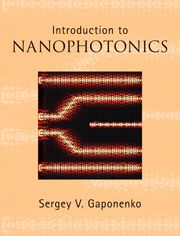Book contents
- Frontmatter
- Contents
- Preface
- Notations and acronyms
- 1 Introduction
- Part I Electrons and electromagnetic waves in nanostructures
- 2 Basic properties of electromagnetic waves and quantum particles
- 3 Wave optics versus wave mechanics I
- 4 Electrons in periodic structures and quantum confinement effects
- 5 Semiconductor nanocrystals (quantum dots)
- 6 Nanoplasmonics I: metal nanoparticles
- 7 Light in periodic structures: photonic crystals
- 8 Light in non-periodic structures
- 9 Photonic circuitry
- 10 Tunneling of light
- 11 Nanoplasmonics II: metal–dielectric nanostructures
- 12 Wave optics versus wave mechanics II
- Part II Light–matter interaction in nanostructures
- Author index
- Subject index
9 - Photonic circuitry
from Part I - Electrons and electromagnetic waves in nanostructures
Published online by Cambridge University Press: 05 June 2012
- Frontmatter
- Contents
- Preface
- Notations and acronyms
- 1 Introduction
- Part I Electrons and electromagnetic waves in nanostructures
- 2 Basic properties of electromagnetic waves and quantum particles
- 3 Wave optics versus wave mechanics I
- 4 Electrons in periodic structures and quantum confinement effects
- 5 Semiconductor nanocrystals (quantum dots)
- 6 Nanoplasmonics I: metal nanoparticles
- 7 Light in periodic structures: photonic crystals
- 8 Light in non-periodic structures
- 9 Photonic circuitry
- 10 Tunneling of light
- 11 Nanoplasmonics II: metal–dielectric nanostructures
- 12 Wave optics versus wave mechanics II
- Part II Light–matter interaction in nanostructures
- Author index
- Subject index
Summary
“The light should be confined gently in order to be confined strongly”.
Y. Akahane et al.The complex propagation of light in periodic and inhomogeneous media considered in previous chapters forms a solid basis for purposeful controlling of light wave propagation and light energy accumulation. Coupling with light sources and light modulators gives rise to the well-defined concept of photonic circuitry. This recently emerged field is becoming more and more mature. The principal solutions in photonic circuitry are overviewed in this chapter. The discussion is kept at an introductory level to provide conceptual ideas and principal approaches without going too deeply into detail. The extensive list of references will partly compensate for the somewhat sketchy style in this chapter.
Microcavities and microlasers
In a sense, an optical microcavity, or a microresonator, can be treated as a wavelength-scale topological construction capable of accumulating and storing light. This can be implemented with respect to light impinging from the outside as well as with respect to light generated inside the cavity under consideration. The word “generated” here implies spontaneous emission, spontaneous Raman scattering rather than necessarily lasing. Light energy accumulation and storage becomes possible by the spatial confinement of light waves in a cavity. Primary examples of (micro)cavities and (micro)resonators were treated in Chapter 3 (Section 3.4) when the resonant tunneling of electromagnetic waves was analyzed; namely a one-dimensional problem of an electromagnetic wave impinging onto a pair of parallel metallic thin film layers serving as mirrors with dielectric spacing (Fig. 3.19).
- Type
- Chapter
- Information
- Introduction to Nanophotonics , pp. 295 - 316Publisher: Cambridge University PressPrint publication year: 2010



